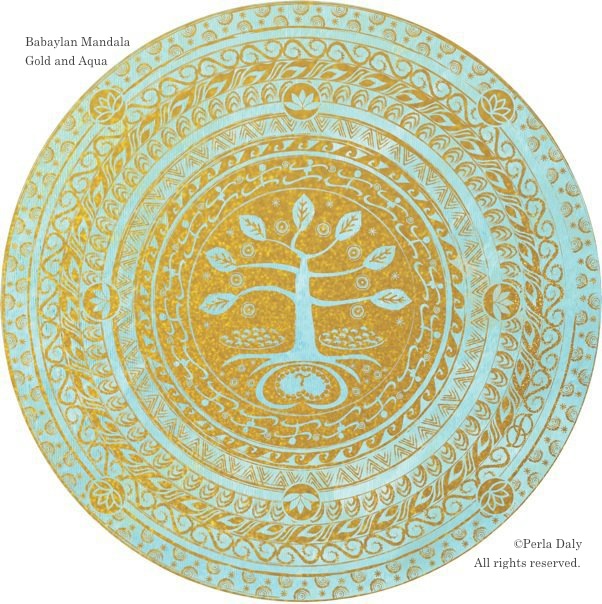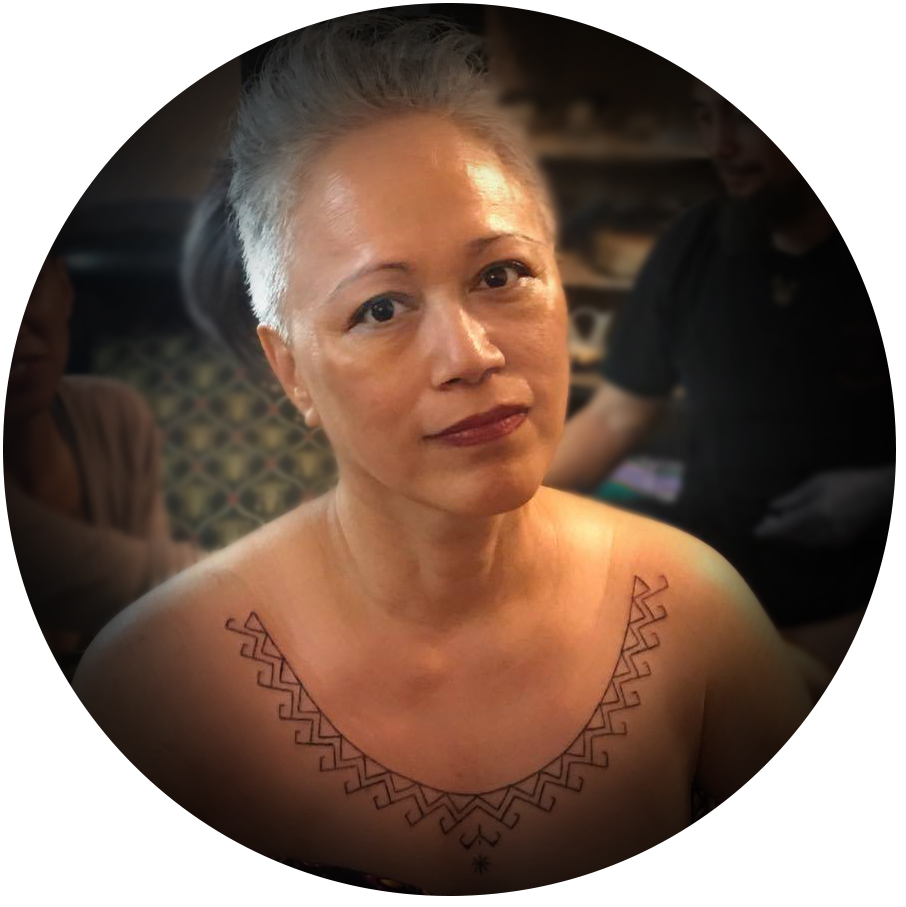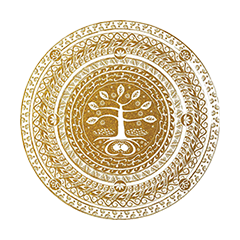BACKGROUND
- whose identity and dignity were fragmented historically
- who lost their connection to their ancestors, their noble beliefs, and their ancestral pride
- who lost the awareness of their inner gold in a striking parallel to the loss of the immense wealth of gold that was once abundant in the islands before the conquistadores brought it back to Spain
Historical background
I began the Babaylan Mandala to be a gift of healing upon colonial, imperial wounding upon my ancestral nation, the Filipinos, islander people, whose land blessed them with abundant gold and natural resources… Four hundred years ago, my ancestors were overcome by Spanish conquistadores who came under orders of King Philip II to Christianize the world, but also to conquer and rule over the natives, ship all gold back on galleons, and make Spain a rich, European and global power.
- the evolution of human consciousness
- seeing and being in Sacred Interconnection
- balancing of mind, body, soul
- wholeness
- integrating left and right brain processes
- connecting to our ancestors
- connecting to our children, their children, and our descendants
- healing of DNA psycho-spiritual and karmic inheritance
- bring Sacred Masculine and Feminine into Union
- expanding our 3D perceptions and connecting to dimensions beyond time and space
- embracing our highest potential and purpose

It began with Filipino symbolism and meanings...
- share a message from the diwa=spirit Babaylan (priestess, community leader, village shaman)
- illustrate magandang kalooban ng tao=human noble traits of the Filipino
ating mga ninuno = our ancestors
pakikipagkapwa = Sacred Interconnection
pagbabalikloob = return to inner, Divine Source
karangalan = dignity
kagitingan = courage
Inang Bayan = Motherland
Mutya = Sacred Feminine
Lalaki = male
binhi = seeds
bunga = blossoming and fruiting
bahala na = harmonize with divine will
Bathala = Supreme Divinity
diwa = idea, concept, spirit, essence
paglilingkod sa kapwa = Community Service
It includes universal symbols...
5 Elements
5 power roles of the Babaylan
Sacred Numbers
Masculine and Feminine Principles
Divine Source
Cosmos
Universal Love
… and more that you will see with your Inner Eye and Heart.
Healing art
Many years ago, after I became a mother, I went on a healing journey and with that I decided to bring healing into this world through whatever I could do. So I use my creativity to imbue healing into my works. How does one try to heal the trauma of historical events?
Art can be a very powerful tool.
Over 400 years ago, the coming of Westerner colonizers significantly shaped the identity of Filipinos.
The archipelago of the Philippines is rich in gold and in pre-colonial times my Inang Bayan (motherland) of the Philippine Islands was known from as afar away as India as Subarna Bhumi or “Land of the Gold.” Ancient Chinese merchant traders called my motherland Ma-Yi.
Ancient mariners and Chinese merchants from afar knew that the Philippine islands were rich in gold because people of all social classes adorned themselves with the precious metal. The maharlika or noble class wore finely crafted, gold-smithed pieces and the alipin or slave class wore stringed nuggets and the simplest gold jewelry.
People came from far away to trade with my ancestors. My ancestors were adept seafarers and were related to the proud Polynesian people. My ancestors travelled by boat to far-away lands, such as the Moluccas Islands and southern Austronesian islands.
With the historical arrival of Spanish conquistadors, the Philippine ancestral gold crafts and mined metal were wrested away and loaded upon Spanish galleons to be delivered across the seas to King Philip II so he could make Spain one of the most powerful countries of Europe and the world. All imperial forces conquer for gold or other natural resources.
As foreigners brought their religion, culture, movies, and commercial products to the Philippines people, something was also lost and replaced within the Philippine people… Something not tangible…
The richness of Philippine ancestral indigenous culture became frowned upon, lost, fragmented, and many beautiful spiritual practices, values and beliefs were forgotten and are still fading away. After the arrival of colonizers, Philippine identity and spirituality became infected with dysfunctional perceptions of the superiority of the conquerors’ race, religion and culture and with innate feelings of inferiority for being “indio” or indigenous. This is the innate, destructive tactic of any imperial invasion and rule (Roman, British, Spanish, American, Japanese, etc).
The Babaylan Mandala is a call to remember Philippine indigenous beauty. It is also a call to the children of Earth to remember their ancestors and their own indigenous connection to Earth/Gaia.
It is time to dismantle centuries-old illusions that humans are separate, divided and are subject to hierarchies of privilege that justify exploitation, pain and suffering in every corner of the Earth.
Filipinos, native people and all humans around the world who have experienced historical imperialism and displacement, patriarchal programming, can experience pagbabalikloob, a return to their deepest inner divine self, a shedding of false beliefs that support institutions that love power and money and devalue human lives in so many ways.
People can awaken, raise their consciousness and stand strong in their identity, history, heritage and the center of their being (kalooban), a sacred inner place, where they can find their inner light, and reclaim their inner gold.
The Babaylan Mandalas and all their symbols, including the 5 elements and baybayin scripts, represent the reclaiming of the Filipinos’ Inner Gold… It represents any person’s reclaiming of their true self.
See these links to discover more info on the Philippines pre-colonial golden heritage:
Historical trivia challenge...
- how imperial Spain enriched itself with gold coming from the Philippines. Most people only know of Inca and Aztec gold.
- how Spanish imperial galleons were built with hardwood coming from ancient rain forests in the Philippines.
- how and when Muslim religion came to the Philippines and replaced indigenous practices.
- how and when Hinduism came to the Philippines and influenced the people and the gold crafts and artifacts.
- the U.S.-Philippine War and the propoganda that justified colonizing a country that had just finished fighting for its independence from Spain.
- how Mark Twain was not only a favorite American writer but also a U.S. anti-imperialist.
- how in 2016 some U.S. Veterans returned the Bell of Balanggiga, war booty from the U.S.-Philippine War, as a gesture of peace and healing.
GLOSSARY
diwa – concept, idea, spirit, soul (sanskrit derivative from diva)
babaylan – Philippine indigenous communities recognize a woman (or man) as a Babaylan, someone who has the ability to mediate with the spirit world, has her own spirit guides, and is given gifts of healing, foretelling, and insight. She may also have knowledge of healing therapies such as hilot (bonesetter, acupressure), arbularyo (herbalist), and as a psycho-spiritual counselor. The babaylan is a ritualist, a chanter, diviner. She has the gift of traveling to the spirit world or non-ordinary states of reality in order to mediate with the spirits. Babaylans are called by other names in the other languages of Philippine indigenous communities: Mombaki, Dawac, Balyan or Balian, Katalonan, Ma-Aram, Mangngallag, Mambunong.
In contemporary contexts, whether in urban Philippines or in Filipino diasporic communities, the Babaylan name is used by those who are inspired by the spirit in which the primary Babaylans carried out their work: the spirit of revolution against colonization, their belief in Sacred Wholeness, their love of mother country, the desire to serve their communities in achieving justice and peace.
If we were to take a non-Filipino word to describe the various healers/spiritual practitioners, a “shaman” would be the closest. Some of our members, in their writings for a Western/Westernized audience, sometimes interchange shaman, “shaman-priest,” or “priestess” but our members also strive to use the local term when referring to a specific person, region, or ethnolinguistic group. Otherwise, it IS indeed a challenge to use English terms to describe or explain our Philippine traditions.
bahala Na – Filipino attitude, in which, he/she is determined to do his/her best and in the face of uncertainty takes courage and thus action. The common Filipino phrase “bahala na” essentially means “I will do my best and trust God to take care of the outcome.”
hiya – sense of propriety
hiyang – appropriateness
kapwa – shared identity; self in other; inner Self/Spirit/Self. In Sikolohiyan Pilipino (Philippine Psychology), kapwa has two categories, ibang tao (other people) and hindi ibang tao (not other people); togetherness; unity of the one-of-us-and-the-other similar to “namaste” or acknowledgement of soul essences that are divinely connected. Also see Pakikipagkapwa.
kapwatid – playful joining of the words kapwa (self in other) and kapatid (sibling)
kagandahang loob – Shared nobility or shared humanity.
kalayaan – freedom, liberty and independence. Emancipation. Being free from form of control in the form of violent action and words.
kasinag – connected inter-personal divine-soul lights; similar to “namaste” or acknowledgement of soul-lights that are divinely connected
katutubong kaalaman – indigenous knowledge
loob – deepest, innermost Self
magkatao – people-centered orientation
mandala – means circle. Mandalas in the Tibetan and Buddhist traditions have spiritual and ritual significance and can represent many things—the journey of a human from birth to enlightenment and the perfection of the cosmos. Mandalas have been used as a spiritual tool for aspirants towards enlightenment.
pagbabalikloob – Return to Self, Return to Source. Decolonization process. Returning to Home.
pagkapilipino – being Filipino
pakikibagay – conformity
pakikipagkapwa – togetherness; sacred interconnection of people and all of Creation. Also see Kapwa.
pakikiramdam – shared inner perceptions. Empathy. Heightened awareness and sensitivity of others emotions and thoughts. Also see Damdam.
pakikisama – Smooth Interpersonal Relationship/s and maintenance thereof. Being united with another, a group, or a community.
panagtagbo– meeting together, collaboration
pakikitungo – civility
pamathalaan – communities
talinghaga – a process of reflection, contemplation… it is thinking and seeing in metaphors, and it entails a matter of inner sight; a part of Filipino holistic thinking. De Guia writes in Kapwa (see CFBS books list) that its “a wholistic lifestyle that was anchored in prayer and devotion.” Talinghaga is quite significant in trying to understand how Filipinos think naturally and how our westernized thinking may not include acknowledgement of the validity of such an ability; anyone can be quite capable of thinking intuitively and logically, and creating a balance between the two types of thinking.
utang ng loob – norm of reciprocity
Many of these definitions are also found at the Center for Babaylan Studies.
Hello, I am the creator of the Babaylan Mandalas. I am a lifelong artist and I use the name BagongPinay on all my works about Philippine culture.
I know when the Philippine Babaylan Spirit rises within any one of us, no matter what nationality we are or what country we are in, She guides us to help us connect to our ancestry, to our genetic roots, our divine Source, to dimensions beyond time and space, to our kapwa in all of creation. The Babaylan spirit helps us find our own Light and precious gold within.
For fun, see if you can find my artist insignia in the mandala. Hint: it’s found with the symbols representing the element of Air.

I'm the artist of the Babaylan Mandala and a visual designer. I'm also a multimedia visual designer, writer, mentor, life and creativity coach.
I love working with deeply creative people who are keenly intuitive and intelligent, seeking not only gnosis,
but also the opening of heart spaces, their higher purpose and ways to serve others.
Contact me to find out more about working together.
